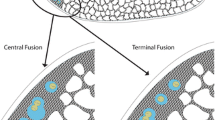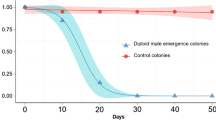Abstract
Under complementary sex determination (CSD), females of Hymenoptera arise from diploid, fertilized eggs and males from haploid, unfertilized eggs. Incidentally, fertilized eggs that inherit two identical alleles at the CSD locus will develop into diploid males. Diploid males are usually unviable or sterile. In a few species, however, they produce diploid sperm and father a triploid female progeny. Diploid males have been reported in a number of social Hymenoptera, but the occurrence of triploid females has hardly ever been documented. Here, we report the presence of triploid females, diploid males, and diploid sperm (produced by diploid males and stored in queen spermathecae) in the ant Tapinoma erraticum. Moreover, we show variations in the frequency of triploids among female castes: Triploid females are more frequent among workers than virgin queens; they are absent among mated, reproductive queens. The frequency of triploid workers also varies between populations and between nests within populations.



Similar content being viewed by others
References
Adams J, Rothman ED, Kerr WE, Paulino ZL (1977) Estimation of the number of sex alleles and queen matings from diploid male frequencies in a population of Apis mellifera. Genetics 86:538–596
Araújo DE, Cavalli-Molina S (2001) Genetic variability and social structure of colonies in Acromyrmex heyeri and A. striatus (Hymenoptera: Formicidae). Braz J Biol 61:667–678
Aron S, de Menten L, Van Bockstaele D (2003) Brood sex determination by flow cytometry in ants. Mol Ecol Notes 3:471–475
Aron S, de Menten L, Van Bockstaele R, Blank SM, Roisin Y (2005) When hymenopteran males reinvented diploidy. Curr Biol 15:824–827
Ayabe T, Hoshiba H, Ono M (2004) Cytological evidence for triploid males and females in the bumblebee, Bombus terrestris. Chrom Res 12:215–223
Beukeboom LW (1995) Sex determination in Hymenoptera: a need for genetic and molecular studies. BioEssays 17:813–817
Boek G (2001) Current status of flow cytometry in cell and molecular biology. Int Rev Cytol 204:239–298
Bourke AFG, Franks NR (1995) Social evolution in ants. Princeton University Press, Princeton 529
Buschinger A, Fischer K (1991) Hybridization of chromosome-polymorphic populations of the inquiline ant, Doronomyrmex kutteri (Hym., Formicidae). Insect Soc 38:95–103
Cook JM (1993) Sex determination in the Hymenoptera: a review of models and evidence. Heredity 71:421–435
Cook JM, Crozier RH (1995) Sex determination and population biology in the Hymenoptera. Trends Ecol Evol 10:281–286
Cournault L, Aron S (2008) Rapid determination of sperm number in ant queens by flow cytometry. Insect Soc 55:283–287
Cowan DP, Stahlhut JK (2004) Functionally reproductive diploid and haploid males in an inbreeding hymenopteran with complementary sex determination. Proc Natl Acad Sci 101:10374–10379
Crozier RH (1971) Heterozygosity and sex determination in haplo-diploidy. Am Nat 105:399–412
Crozier RH, Pamilo PP (1996) Evolution of social insect colonies—sex allocation and kin selection. Oxford University Press, New York
de Boer JG, Ode PJ, Vet LEM, Whitfield J, Heimpel GE (2007) Diploid males sire triploid daughters and sons in the parasitoid wasp Cotesia vestalis. Heredity 99:288–294
Dobson SL, Tanouye MA (1998) Evidence for a genomic imprinting sex determination mechanism in Nasonia vitripennis (Hymenoptera: Chalcidoidea). Genetics 149:233–242
Fernández-Escudero I, Pamilo P, Seppä P (2002) Biased sperm use by polyandrous queens of the ant Proformica longiseta. Behav Ecol Sociobiol 51:207–213
Foitzik S, Heinze J (2001) Microgeographic structure and intraspecific parasitism in the ant Leptothorax nylanderi. Ecol Entomol 26:449–456
Hammond RL, Bourke AFG, Bruford MW (2001) Mating frequency and mating system of the polygynous ant, Leptothorax acervorum. Mol Ecol 10:2719–2728
Herbers JM, Grieco S (1994) Population structure of Leptothorax ambiguuus, a facultatively polygynous and polydomous ant species. J Evol Biol 7:581–598
Hung ACF, Imai HT, Kubota M (1972) The chromosomes of nine ant species (Hymenoptera: Formicidae) from Taiwan, Republic of China. Ann Entomol Soc Am 65:1023–1025
Inaba F (1939) Diploid males and triploid females of the parasitic wasp, Habrobracon pectiophorae Watanabe. Cytologia (Tokyo) 9:517–523
Kerr WE, Nielsen RA (1967) Sex determination in bees (Apinae). J Apicult Res 6:3–9
Krieger MJB, Ross KG, Chang CWY, Keller L (1999) Frequency and origin of triploidy in the fire ant Solenopsis invicta. Heredity 82:142–150
Kron P, Suda J, Husband BC (2007) Applications of flow cytometry to evolutionary and population biology. Annu Rev Ecol Evol Syst 38:847–876
Liebert AE, Sumana A, Starks PT (2005) Diploid males and their triploid offspring in the paper wasp Polistes dominulus. Biol Lett 1:200–203
Liebert AE, Johnson RN, Switz GT, Starks PT (2004) Triploid females and diploid males: underreported phenomena in Polistes wasps? Insect Soc 51:205–211
Loiselle R, Francoeur A, Fischer K, Buschinger A (1990) Variations and taxonomic significance of the chromosome numbers in the nearctic species of the genus Leptothorax (s.s.)(Formicidae: Hymenoptera). Caryologia 43:321–334
Meudec M (1973) Cycle biologique de Tapinoma erraticum (Formicidae, Dolichoderinae). Ann Soc Entomol Fra 9:381–389
Meudec M (1979) Comportement d’émigration chez la fourmi Tapinoma erraticum (Dolichoderinae); un exemple de regulation sociale. Ph.D. thesis, Univesité F. Rabelais, Tours
Naito T, Suzuki H (1991) Sex determination in the sawfly, Athalia rosae ruficornis (Hymenoptera): occurrence of triploid males. J Hered 82:101–104
Pamilo P, Sundström L, Fortelius W, Rosengren R (1994) Diploid males and colony-level selection in Formica ants. Ethol Ecol Evol 6:221–235
Pearson B (1982) The taxonomic status of morphologically anomalous ants of the Lasius niger/Lasius alienus taxon. Insect Soc 29:95–101
Pearson B (1983) Hybridization between the ant species Lasius niger and Lasius alienus: the genetic evidence. Insect Soc 30:402–411
Petters RM, Mettus RV (1980) Decreased diploid male viability in the parasitic wasp, Bracon hebetor. J Hered 71:353–356
Ross KG (2001) Molecular ecology of social behaviour: analyses of breeding systems and genetic structure. Mol Ecol 10:265–284
Ross KG, Fletcher DJC (1985) Genetic origin of male diploidy in the fire ant, Solenopsis invicta (Hymenoptera: Formicidae) and its evolutionary significance. Evolution 39:888–903
Ross KG, Fletcher DJC (1986) Diploid male production—a significant colony mortality factor in the fire ant Solenopsis invicta (Hymenoptera: Formicidae). Behav Ecol Sociobiol 19:283–291
Ross KG, Vargo EL, Keller L, Trager JC (1993) Effect of a founder event on variation in the genetic sex-determining system of the fire ant Solenopsis invicta. Genetics 135:843–854
Santomauro G, Oldham NJ, Boland W, Engels W (2004) Cannibalism of diploid drone larvae in the honeybee (Apis mellifera) is released by odd pattern of cuticular substances. J Apicult Res 43:69–74
Schrempf A, Aron S, Heinze J (2006) Sex determination and inbreeding depression in an ant with regular sib-mating. Heredity 97:75–80
Smith SG, Wallace DR (1971) Allelic sex determination in a lower hymenopteran, Neodiprion nigroscutum Midd. Canad J Genet Cytol 13:617–621
Takahashi J, Ayabe T, Mitsuhata M, Shimizu I, Ono M (2008) Diploid male production in a rare and locally distributed bumblebee, Bombus florilegus (Hymenoptera, Apidae). Insect Soc 55:43–50
Van Wilgenburgh E, Driessen G, Beukeboom LW (2006) Single locus complementary sex determination in Hymenoptera: an “unintelligent” design? Front Zool 3:1
Ward PS (1980) Genetic variation and population differentiation in the Rhytidoponera impressa group, a species complex of ponerine ants (Hymenoptera: Formicidae). Evolution 34:1060–1076
Wedemeyer N, Potter T (2001) Flow cytometry: an ‘old’ tool for novel applications in medical genetics. Clin Genet 60:1–8
Whiting PW (1943) Multiple alleles in complementary sex determination of Habrobracon. Genetics 28:365–382
Yamauchi K, Yoshida T, Ogawa T, Itoh S, Ogawa Y, Jimbo S, Imai HT (2001) Spermatogenesis of diploid males in the formicine ant, Lasius sakagamii. Insect Soc 48:28–32
Acknowledgments
LC thanks N. Thurin, A. Bernadou, and A. Lenoir for their help in collecting samples. Authors gratefully acknowledge M. Pearcy for his critical reading of the manuscript and fruitful suggestions. We thank three anonymous referees for their helpful remarks on a previous version of the manuscript. Financial support was provided by the Belgian “Fonds pour la Formation à la Recherche dans l’Industrie et l’Agriculture” (research fellowship to LC), the Belgian National Fund for Scientific Research through personal (research director) and grants (to SA).
Author information
Authors and Affiliations
Corresponding author
Rights and permissions
About this article
Cite this article
Cournault, L., Aron, S. Diploid males, diploid sperm production, and triploid females in the ant Tapinoma erraticum . Naturwissenschaften 96, 1393–1400 (2009). https://doi.org/10.1007/s00114-009-0590-1
Received:
Revised:
Accepted:
Published:
Issue Date:
DOI: https://doi.org/10.1007/s00114-009-0590-1




